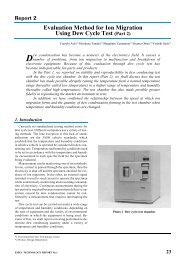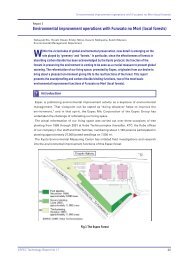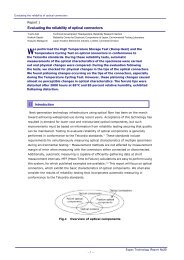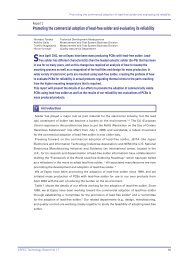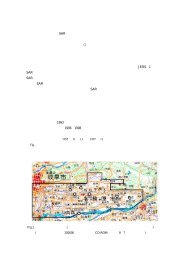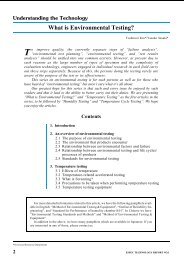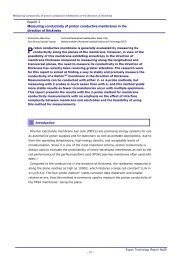download
download
download
Create successful ePaper yourself
Turn your PDF publications into a flip-book with our unique Google optimized e-Paper software.
Measuring Conductivity of Proton Conductive Membrane in the direction of thickness, partⅡ:<br />
using the 4-probe method in the direction of thickness<br />
2-2 Specimen preparation<br />
2-2-1 Preparation of reference electrodes<br />
Three types of coated wire with insulating layer were used as reference electrodes (also known<br />
as electric potential sampling electrodes) to examine effects of the coating and the conducting<br />
materials on the measuring performance of the MEA specimen.<br />
(a) Cu/polyester coated wire: ready-made product used as listed in Table 1.<br />
(b) Pt/Teflon coated wire: ready-made product used as listed in Table 1.<br />
(c) Pt/insulating varnish coated wire: coating film formed on Pt wire by soaking bare Pt wire in<br />
Varnish No. 7031 solution diluted with solvent mixture of ethyl alcohol and toluene 50:50 by<br />
volume, and followed by drying in vacuum at 100℃ for 5 hours.<br />
2-2-2 Manufacturing MEA specimens for the 4-probe method in the direction of thickness<br />
Using the above three types of coated wires, reference electrodes were prepared by cutting one<br />
end obliquely to be used as the electric potential sampling electrode terminal and peeling the<br />
other end of the wire about 1 cm to be used as the connecting terminal into other external<br />
devices.<br />
Two steps were involved in the manufacturing process of premium MEA specimens in this<br />
context.<br />
First, the reference electrode was imbedded into the current lead-in membrane by placing one<br />
reference electrode on a 50μm-thick Teflon sheet with its bevel section exactly toward the film<br />
surface, covering that with a current lead-in membrane and another Teflon sheet in sequence,<br />
and then following with a hot-pressing treatment at 150℃ and 400 kgf cm -2 . Second, after<br />
removing the Teflon sheets, the MEA specimen was fabricated by sandwiching two current<br />
lead-in membrane units made above and one test membrane pretreated under the appointed<br />
temperature, pressure and chemical conditions, with the bevel sections situated opposite each<br />
other and located at equipotential positions, e.g., the center of the test membrane, and then<br />
hot-pressing them at 150℃ and 20 kgf cm -2 . The schematic construction of the MEA specimen as<br />
obtained above for the 4-probe method in the direction of thickness is shown in Fig.1.<br />
- 4 -<br />
Espec Technology Report No.23



